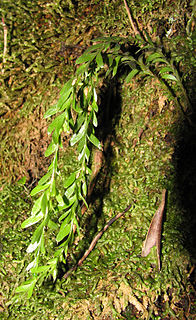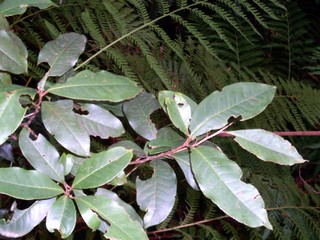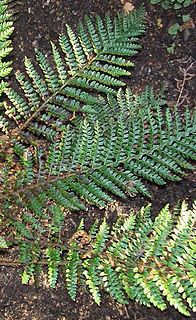
The tree ferns are arborescent (tree-like) ferns that grow with a trunk elevating the fronds above ground level, making them trees. Most tree ferns are members of the "core tree ferns", belonging to the families Cyatheaceae, Dicksoniaceae, Metaxyaceae, and Cibotiaceae in the order Cyatheales. It is estimated that Cyatheales originated in the early Jurassic, and is the third group of ferns known to have given rise to tree-like forms. The others are the extinct Tempskya of uncertain position, and Osmundales where the extinct Guaireaceae and some members of Osmundaceae also grew into trees. In addition there was the Psaroniaceae and Tietea in the Marattiales, which is the sister group to true ferns.

The order Cyatheales, which includes most tree ferns, is a taxonomic order of the fern class, Polypodiopsida. No clear morphological features characterize all of the Cyatheales, but DNA sequence data indicate the order is monophyletic. Some species in the Cyatheales have tree-like growth forms from a vertical rhizome, others have shorter or horizontal expanding rhizomes.

Dicksonia is a genus of tree ferns in the order Cyatheales. It is regarded as related to Cyathea, but is considered to retain more primitive traits, dating back at least to the Jurassic and Cretaceous periods. The fossil record includes stems, pinnules, and spores.

Dicksonia antarctica, the soft tree fern or man fern, is a species of evergreen tree fern native to eastern Australia, ranging from south-east Queensland, coastal New South Wales and Victoria to Tasmania.

Sphaeropteris cooperi, synonym Cyathea cooperi, also known as lacy tree fern, scaly tree fern, or Cooper's tree fern, is a tree fern native to Australia, in New South Wales and Queensland.

Dicksonia squarrosa, the New Zealand tree fern, whekī or rough tree fern, is a common tree fern endemic to New Zealand. It has a slender black trunk that is usually surrounded by many dead brown fronds.

Dicksoniaceae is a group of tropical, subtropical and warm temperate ferns, treated as a family in the Pteridophyte Phylogeny Group classification of 2016, and counting 30-40 species. Alternatively, the family may be sunk into a very broadly defined family Cyatheaceae sensu lato as the subfamily Dicksonioideae. Most of the genera in the family are terrestrial ferns or have very short trunks compared to tree ferns of the family Cyatheaceae sensu stricto. However, some of the larger species can reach several metres in height. A number of others are epiphytes. They are found mostly in tropical regions in the Southern Hemisphere, as far south as southern New Zealand. Larger tree ferns in the genus Cibotium were formerly included in Dicksoniaceae, but are now segregated as the family Cibotiaceae.

Sphaeropteris medullaris, synonym Cyathea medullaris, commonly known as mamaku or black tree fern, is a large tree fern up to 20 m tall. It is distributed across the south-west Pacific from Fiji to Pitcairn Island. Its other Māori names include katātā, kōrau, or pītau.

Alsophila australis, synonym Cyathea australis, also known as the rough tree fern, is a species of tree fern native to southeastern Queensland, New South Wales and southern Victoria in Australia, as well as Tasmania and Norfolk Island.

Alsophila dregei, synonym Cyathea dregei, is a widespread species of tree fern in southern Africa.

Alsophila smithii, synonym Cyathea smithii, commonly known as the soft tree fern or kātote, is a species of tree fern from New Zealand.

Tmesipteris, the hanging fork ferns, is a genus of ferns, one of two genera in the family Psilotaceae, order Psilotales . Tmesipteris is restricted to certain lands in the Southern Pacific, notably Australia, New Zealand and New Caledonia. In New Zealand this hanging epiphyte is common in the warm temperate rain forests of both main islands, where it can normally be found as short spiky dark-green fronds, often with lighter bag-like sporangia at the bases of some of its "leaves". The plant possesses no true leaves; what appear to be leaves are flattened stems. The fronds emerge directly from the fibrous root-mats which clad the trunks of mature tree ferns such as Dicksonia and Cyathea. Tmesipteris is from the Greek language, meaning a "cut fern", referring to the truncated leaf tips.

A stem is one of two main structural axes of a vascular plant, the other being the root. It supports leaves, flowers and fruits, transports water and dissolved substances between the roots and the shoots in the xylem and phloem, stores nutrients, and produces new living tissue.

Quintinia sieberi, known as possumwood, is a rainforest tree of eastern Australia. It is mostly found in rainforests at high altitude. The range of natural distribution is between the Clyde River, New South Wales and the McPherson Range just over the border in the state of Queensland.

Polystichum proliferum, commonly known as mother shield fern is an Australian endemic fern. The genus name Polystichum is derived from Greek poly - many, and stichos - rows referring to the many rows of sori. The species name is derived from Latin, Proli – offspring and fer - bearing referring to the proliferous buds, a prominent feature of the species.

Dicksonia fibrosa, the golden tree fern, whekī-ponga or kuripaka is a species of medium-sized tree fern native to New Zealand.
Tasmania is home to 'Australia’s largest cool temperate rainforests... Most of Tasmania’s rainforests occur in the North-West and throughout the North East highlands. Cool temperate rainforests typically have a heavy rainfall, cool climate, favor high altitudes and have a limited availability of light.

Polyphlebium venosum, the veined bristle-fern or bristle filmy fern, is a fern in the family Hymenophyllaceae. It is only found in wet forests, mainly growing as an epiphyte on the shady side of the soft tree fern, Dicksonia antartica. It also grows on logs, trunks of trees and rarely on trunks of Cyathea species or on wet rock-faces. It is found in the wetter parts of Eastern Australia and New Zealand. P. venosum has poor long-distance dispersal compared to other ferns due to its short lived spore. Notable features of Polyphlebium venosum include it being one cell layer thick, 5–15 cm in length, having many branching veins and a trumpet shaped indusium.
Dicksonia lanata is a fern endemic to New Zealand. Colloquial names include stumpy tree fern, tūākura and tūōkura.

Lastreopsis hispida, known as the bristly shield fern, is a common plant found in New Zealand. Less often seen in Australia, in cool rainforest areas with humus rich soils, or more rarely as an epiphyte on tree ferns or mossy logs. Listed as endangered in the state of New South Wales where it grows in a few remote sites in the Blue Mountains, such as at Mount Wilson. The specific epithet hispida is from Latin, meaning "bristly".















